![]()
![]()
![]()
Use LEFT and RIGHT arrow keys to navigate between flashcards;
Use UP and DOWN arrow keys to flip the card;
H to show hint;
A reads text to speech;
60 Cards in this Set
- Front
- Back
|
What is epithelial tissue? |
The tissue that forms the innermost and outermost surfaces of body structures and forms glands. Also called epithelium. |
|
|
What are the 3 major function of epithelial tissue? |
(1) a selective barrier that limits or aids the transfer of substances into and out of the body; (2) a secretory surface that releases products produced by the cells onto its free surfaces; and (3) a protective surface that resists the abrasive influences of the environment. |
|
|
The apical (free) surface faces what? |
Faces the body surface, a body cavity, the lumen (interior space) of an internal organ, or a tubular duct that receives cell secretions. |
|
|
Apical surfaces may contain what? |
cilia or microvilli |
|
|
The lateral surfaces of an epithelial cell faces what? |
face the adjacent cells on either side |
|
|
The lateral surface may contain what kind of junctions? |
Tight junctions, adherens junctions, desmosomes, and/or gap junctions. |
|
|
The basal surface of an epithelial cell is opposite of what? |
The apical surface. |
|
|
The basal surface adheres to what? |
Adhere to extracellular materials such as the basement membrane. |
|
|
What are the functions of the basement membrane? |
The basement membrane provides physical support for the epithelial tissue and plays a part in growth and wound healing, restriction of molecular movement between tissues, and blood filtration in the kidneys. |
|
|
The basal lamina is secreted by what? It contains what? |
Secreted by epithelial cells. It contains proteins such as laminin and collagen, as well as glycoproteins and proteoglycans. |
|
|
The reticular lamina is closer to what? It contains what? |
Closer to the underlying connective tissue and contains proteins such as collagen produced by connective tissue cells called fibroblasts. |
|
|
Epithelial tissue may be divided into two types. What are they? |
(1) Covering and lining epithelium (2) Glandular epithelium |
|
|
Types of covering and lining epithelial tissue are classified according to two characteristics. What are they? |
The arrangement of cells into layers and the shapes of the cells. |
|
|
What are the possible arrangements of cells into layers? Briefly define. |
Simple epithelium: single layer of cells (functions in diffusion, osmosis, filtration, secretion, or absorption) Pseudostratified epithelium: appears to have multiple layers of cells; actually a simple epithelium Stratified epithelium: 2 or more layers protect underlying tissues |
|
|
What are the possible cell shapes? Briefly define. |
Squamous cells: thin Cuboidal cells: cubes or hexagons, may have microvilli Columnar cells: like columns, may have microvilli or cilia Transitional cells change shape, from squamous to cuboidal and back in organs that stretch and collapse |
|

What type of arrangement of layers is this? |
Simple |
|
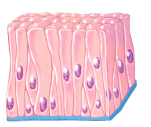
What type of arrangement of layers is this? |
Pseudostratified |
|
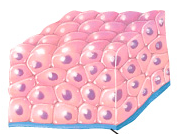
What type of arrangement of layers is this? |
Stratified |
|

What type of cell shape is this? |
Squamous |
|

What type of cell shape is this? |
Cuboidal |
|

What type of cell shape is this? |
Columnar |
|
|
Which cell shape is best adapted for the rapid movement of substances from one cell to another? |
Because the cells are so thin, substances move most rapidly through squamous cells. |
|
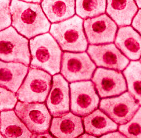
What type of tissue is this? |
Simple Squamous Epithelium |
|
|
Where do you find simple squamous epithelium? |
Most commonly (1) lines the cardiovascular and lymphatic system (heart, blood vessels, lymphatic vessel linings, called endothelium) (2) forms the epithelial layer of serous membranes (peritoneum, pleura, pericardium), where it is called mesothelium. Also found in air sacs of lungs, glomerular (Bowman's) capsule of kidneys, inner surface of tympanic membrane. |
|
|
What is the function of simple squamous epithelium? |
Present at sites of filtration, diffusion, secretion. Not found in body areas subject to mechanical stress (wear and tear). |
|
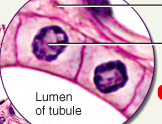
What type of tissue is this? |
Simple Cuboidal Epithelium |
|
|
Where would you find simple cuboidal epithelium? |
Ovary, lens of the eye, retina of the eye, kidney tubules, secreting portion of thyroid gland and ducts of some glands such as pancreas. |
|
|
What are the functions of simple cuboidal epithelium? |
Secretion and absorption. |
|
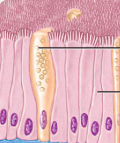
What type of tissue is this? |
Nonciliated simple columnar epithelium |
|
|
Where would you find nonciliated simple columnar epithelium? |
Lines gastrointestinal tract (from stomach to anus), ducts of many glands, and gallbladder. |
|
|
What are the functions of nonciliated simple columnar epithelium? |
Secretion and absorption |
|
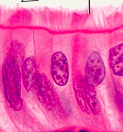
What type of tissue is this? |
ciliated simple columnar epithelium |
|
|
Where would you find ciliated simple columnar epithelium? |
Lines some bronchioles (small tubes) of respiratory tract, uterine (fallopian) tubes, uterus, some paranasal sinuses, central canal of spinal cord, and ventricles of brain. |
|
|
What are the functions of ciliated simple columnar epithelium? |
Moving mucus and foreign particles, move oocytes expelled from ovaries through uterine (fallopian) tubes into uterus.. |
|
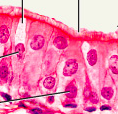
What type os tissue is this? |
pseudostratified columnar epithelium |
|
|
Where would you find pseudostratified columnar epithelium? |
Ciliated variety lines airways of most of upper respiratory tract; nonciliated variety lines larger ducts of many glands, epididymis, and part of male urethra. |
|
|
What are the functions of pseudostratified columnar epithelium? |
Ciliated variety secretes mucus that traps foreign particles, and cilia sweep away mucus for elimination from body; nonciliated variety functions in absorption and protection. |
|
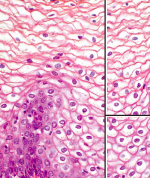
What type of tissue is this? |
stratified squamous epithelium |
|
|
Where would you find stratified squamous epithelium? |
Keratinized variety forms superficial layer of skin; nonkeratinized variety lines wet surfaces (lining of mouth, esophagus, part of epiglottis, part of pharynx, and vagina) and covers tongue. |
|
|
What are the functions of stratified squamous epithelium? |
Protection against abrasion, water loss, ultraviolet radiation, and foreign invasion. Both types form first line of defense against microbes. |
|
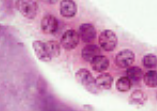
What type of tissue is this? |
stratified cuboidal epithelium |
|
|
Where would you find stratified cuboidal epithelium? |
Ducts of adult sweat glands and esophageal glands, part of male urethra. |
|
|
What are the functions of stratified cuboidal epithelium? |
Protection; limited secretion and absorption. |
|
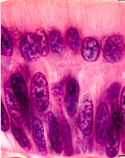
What type of tissue is this? |
stratified columnar epithelium |
|
|
Where would you find stratified columnar epithelium? |
Lines part of urethra; large excretory ducts of some glands, such as esophageal glands; small areas in anal mucous membrane; part of conjunctiva of eye. |
|
|
What are the functions of stratified columnar epithelium? |
Protection and secretion. |
|
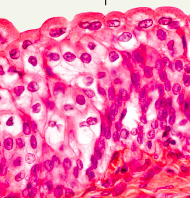
What type of tissue is this? |
transitional epithelium |
|
|
Where would you find transitional epithelium? |
Lines urinary bladder and portions of ureters and urethra. |
|
|
What are the functions of transitional epithelium? |
Allows urinary organs to stretch and maintain protective lining while holding variable amounts of fluid without rupturing. |
|
|
What is an endocrine gland? |
A gland that secretes hormones into interstitial fluid and then the blood; a ductless gland. |
|
|
What is an exocrine gland? |
A gland that secretes its products into ducts that carry the secretions into body cavities, into the lumen of an organ, or to the outer surface of the body. |
|
|
What are unicellular glands? Multicellular glands? Simple glands? Compound glands? Tubular glands? Acinar glands? Tubuloacinar glands? |
Unicellular: single-celled Multicellular: multi-celled Simple: duct does not branch Compound: duct branches Tubular: tubular secretory part Acinar: rounded secretory part Tubuloacinar: tubular and rounded secretory parts |
|
|
How do simple multicellular exocrine glands differ from compound ones? |
Simple multicellular exocrine glands have a nonbranched duct; compound multicellular exocrine glands have a branched duct. |
|
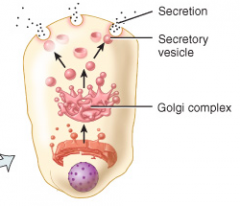
What kind of secretion is this? |
Merocrine secretion |
|
|
What is a merocrine gland? |
Gland made up of secretory cells that remain intact throughout the process of formation and discharge of the secretory product, as in the salivary and pancreatic glands. |
|
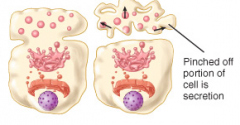
What kind of secretion is this? |
Apocrine secretion |
|
|
What is an apocrine gland? |
A type of gland in which the secretory products gather at the free end of the secreting cell and are pinched off, along with some of the cytoplasm, to become the secretion, as in mammary glands. |
|
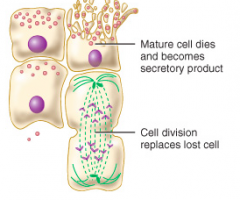
What kind of secretion is this? |
Holocrine secretion |
|
|
What is a holocrine gland? |
A type of gland in which entire secretory cells, along with their accumulated secretions, make up the secretory product of the gland, as in the sebaceous (oil) glands. |
|
|
To what class of glands do sebaceous (oil) glands belong? Salivary glands? |
Sebaceous (oil) glands are holocrine glands, and salivary glands are merocrine glands. |

